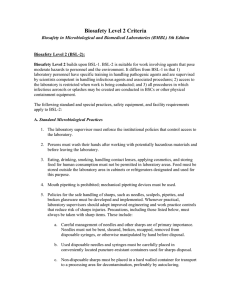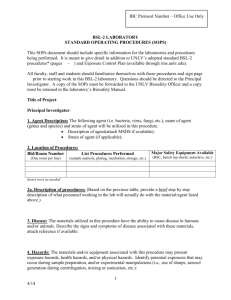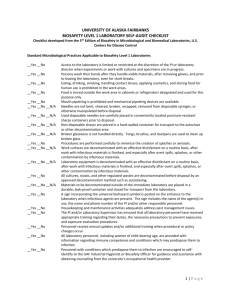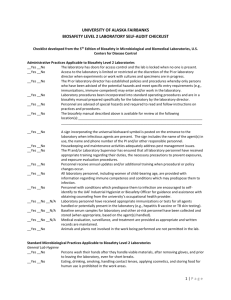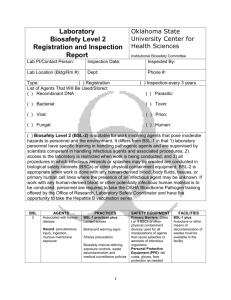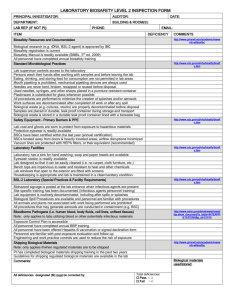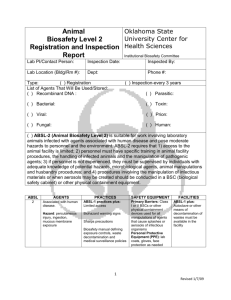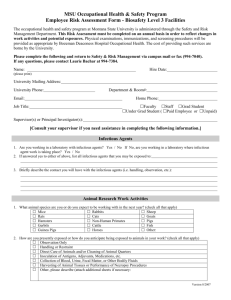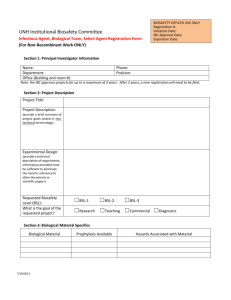BSL-2_Lab_Audit
advertisement
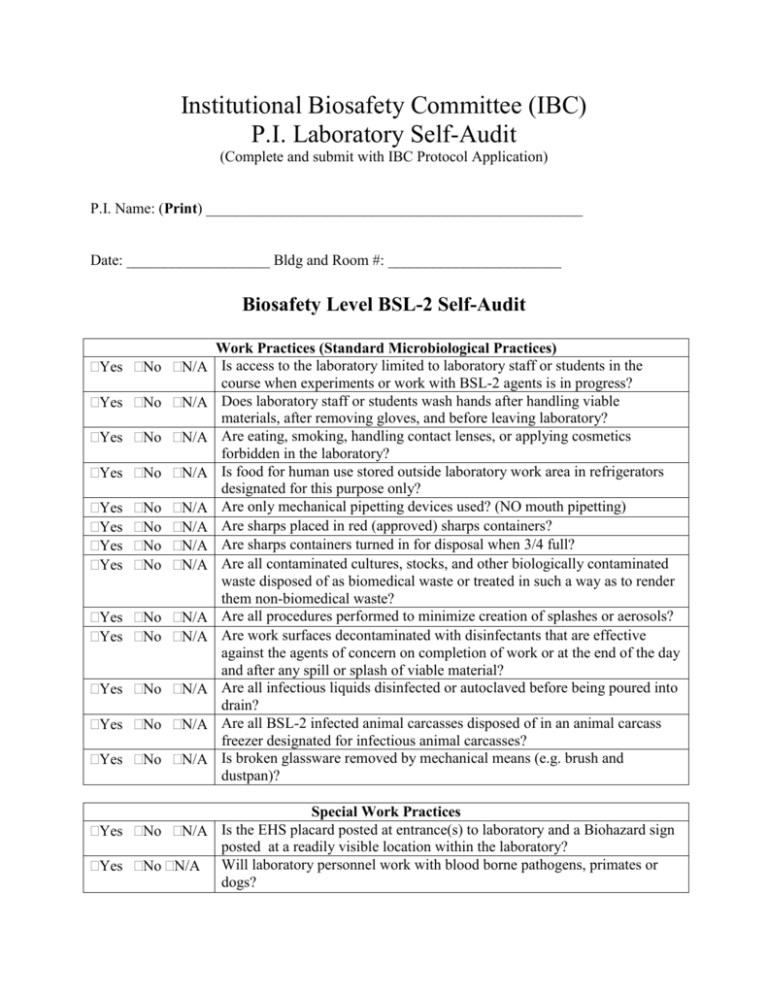
Institutional Biosafety Committee (IBC) P.I. Laboratory Self-Audit (Complete and submit with IBC Protocol Application) P.I. Name: (Print) __________________________________________________ Date: ___________________ Bldg and Room #: _______________________ Biosafety Level BSL-2 Self-Audit Yes No N/A Yes No N/A Yes No N/A Yes No N/A Yes Yes Yes Yes No No No No N/A N/A N/A N/A Yes No N/A Yes No N/A Yes No N/A Yes No N/A Yes No N/A Work Practices (Standard Microbiological Practices) Is access to the laboratory limited to laboratory staff or students in the course when experiments or work with BSL-2 agents is in progress? Does laboratory staff or students wash hands after handling viable materials, after removing gloves, and before leaving laboratory? Are eating, smoking, handling contact lenses, or applying cosmetics forbidden in the laboratory? Is food for human use stored outside laboratory work area in refrigerators designated for this purpose only? Are only mechanical pipetting devices used? (NO mouth pipetting) Are sharps placed in red (approved) sharps containers? Are sharps containers turned in for disposal when 3/4 full? Are all contaminated cultures, stocks, and other biologically contaminated waste disposed of as biomedical waste or treated in such a way as to render them non-biomedical waste? Are all procedures performed to minimize creation of splashes or aerosols? Are work surfaces decontaminated with disinfectants that are effective against the agents of concern on completion of work or at the end of the day and after any spill or splash of viable material? Are all infectious liquids disinfected or autoclaved before being poured into drain? Are all BSL-2 infected animal carcasses disposed of in an animal carcass freezer designated for infectious animal carcasses? Is broken glassware removed by mechanical means (e.g. brush and dustpan)? Special Work Practices Yes No N/A Is the EHS placard posted at entrance(s) to laboratory and a Biohazard sign posted at a readily visible location within the laboratory? Yes No N/A Will laboratory personnel work with blood borne pathogens, primates or dogs? Yes No N/A If yes, will laboratory personnel be screened for appropriate immunizations, etc., before working with the blood borne pathogens, primates or dogs? Yes No N/A Are persons who are at increased risk of acquiring infection, or for whom infection may have serious consequences, not allowed to enter the laboratory when work with infectious agents is in progress without permission of Principal Investigator or instructor? Yes No N/A Has P.I. or instructor developed a BSL-2 Safety SOP and posted the SOP in the lab? Yes No N/A Does Safety SOP establish policies and procedures whereby only persons who have been advised of the potential hazards and met specific entry requirements (e.g. immunization) allowed to enter laboratory while procedures with BSL-2 agents are in progress? Yes No N/A Are animals not involved in the work being performed prohibited in the lab? Yes No N/A Are support personnel and students trained and made aware of hazards and SOP before working in the laboratory? Yes No N/A Are spills and accidents that result in overt exposures to infectious materials immediately reported to the Principal Investigator or instructor? Yes No N/A Is appropriate medical evaluation provided? Yes No N/A Is laboratory equipment and work area decontaminated with an effective disinfectant on a routine basis, or after work with infectious materials is finished, and especially after overt spills, splashes, or other contamination? Yes No N/A Is contaminated equipment decontaminated before it is repaired in the laboratory or sent out of the laboratory for maintenance or other purposes? Yes No N/A Is personal protective equipment worn as appropriate when working with viable microorganisms, animals and chemicals? Yes No N/A Yes No N/A Yes No N/A Yes No N/A Yes No N/A Yes No N/A Yes No N/A Safety Equipment (Primary Barrier) Is face protection (goggles, mask, face shield, or other splatter guards) used for anticipated splashes or sprays of infectious or other hazardous materials when manipulated outside a biological safety cabinet? Is protective clothing removed and left in laboratory before going to non-laboratory areas (cafeteria, library, administrative areas)? Is protective clothing either disposed of in laboratory or laundered by institution? (NEVER taken home!) Does the laboratory perform procedures with a potential for creating infectious aerosols or splashes or handle high concentrations of infectious materials? Does the laboratory have access to a Biosafety Cabinet? (Location: ) a. Is Biosafety Cabinet annual certification current? b. Is Biosafety Cabinet installed away from doors, high traffic areas, ventilation devices, or other equipment that could disrupt airflow patterns needed for containment? Yes No N/A Does the laboratory centrifuge high concentrations or large volumes of infectious agents? Yes No N/A If yes, does the centrifuge have sealed rotor heads or centrifuge safety cups? Yes No N/A Yes No N/A Yes No N/A Yes No N/A Yes No N/A Yes No N/A Yes Yes Yes Yes No No No No N/A N/A N/A N/A Laboratory Facilities (Secondary Barriers) Does laboratory have doors that lock? Does laboratory have a sink for hand washing? Is laboratory designed so that it can be easily cleaned? (Cloth upholstery, carpets and rugs are not allowed in laboratory work areas). Are bench tops impervious to water and resistant to heat, organic solvents, acids, alkalis, and chemicals used to decontaminate the work surface and equipment? Is laboratory furniture and cabinetry in good condition and capable of supporting loads and uses? Are spaces between benches, cabinets, and equipment accessible for cleaning? Are eyewash/eyewash stations readily available? Is illumination level adequate? Is an autoclave readily available and easily accessible? Is an insect and rodent control program in effect for the laboratory? Signature of Principal Investigator:___________________________________________ Date: _______________________ Signature of Compliance Officer: __________________________________________ Date: _______________________ (The Compliance Officer will review checklist and ensure that lab meets health and safety requirements AFTER submission of the project application. Attach the form to your IBC application packet without the Compliance Officer’s signature.) Print form and continue to next process >>>
